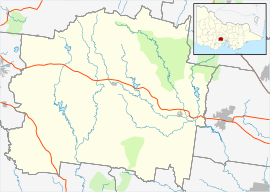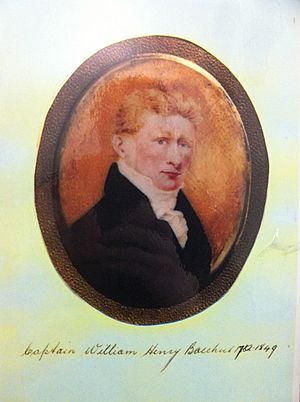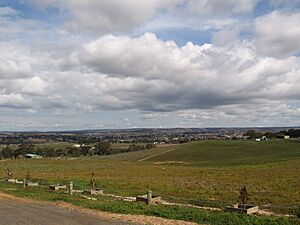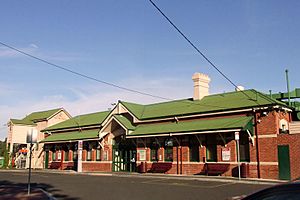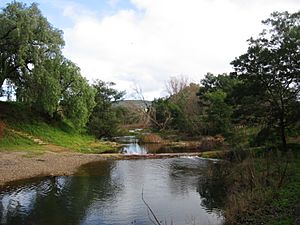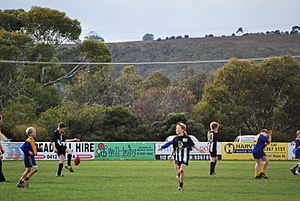Bacchus Marsh facts for kids
Quick facts for kids Bacchus MarshVictoria |
|||||||||||||||
|---|---|---|---|---|---|---|---|---|---|---|---|---|---|---|---|
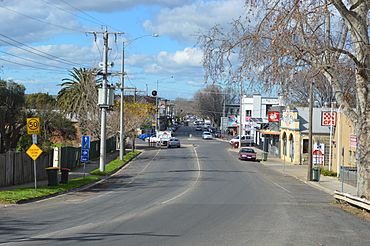
Main St, Bacchus Marsh
|
|||||||||||||||
| Population |
|
||||||||||||||
| • Density | 125.91/km2 (326.1/sq mi) | ||||||||||||||
| Postcode(s) | 3340 | ||||||||||||||
| Elevation | 118 m (387 ft) | ||||||||||||||
| Area | 196.3 km2 (75.8 sq mi) | ||||||||||||||
| Location | |||||||||||||||
| LGA(s) | Shire of Moorabool | ||||||||||||||
| State electorate(s) | Eureka | ||||||||||||||
| Federal Division(s) | Hawke | ||||||||||||||
|
|||||||||||||||
Bacchus Marsh is a town in Victoria, Australia. It's about 50 kilometers (31 miles) north-west of Melbourne. It's also almost the same distance from the major cities of Ballarat and Geelong.
In 2021, the town itself had about 7,808 people. But if you include nearby areas like Darley and Maddingley, the population is much larger, around 24,717. Bacchus Marsh is the biggest town in the Shire of Moorabool area.
For a long time, Bacchus Marsh was known for its market gardens. These farms grew lots of fruits and vegetables for the region. More recently, it has become a popular place for people who work in Melbourne or Ballarat to live. They travel (or commute) to work each day.
The town was named after Captain William Henry Bacchus. He was an early settler who saw how valuable the area was. This was because it sat between two rivers: the Lerderderg and Werribee rivers. The local Wathawurrung name for the area is Pullerbopulloke.
Contents
A Look Back at Bacchus Marsh's History
First Peoples of the Land
Bacchus Marsh is located on the traditional lands of the Kulin Nation. This area sits between the territories of the Woiwurrung and Wathaurong peoples. The local groups were the Marpeang balug of the Wathaurong and the Gunung-willam-bulluk (Wurundjeri) of the Woiwurrung.
This area was a very important meeting place for Aboriginal people. Even after European settlers arrived, many Aboriginal people would gather here. They held special ceremonies called corroborees regularly. The Wathawurrung name for the area, Pullerbopulloke, means "place of the lake".
European Settlement Begins
One of the first Europeans to explore the Bacchus Marsh valley was Kenneth Scobie Clarke. He arrived in 1836 with a large group of sheep. Clarke built a small hut near the Lerderderg River and lived there for a while.
In 1838, Captain William Henry Bacchus and his son, William Henry Bacchus junior, also came to the area. They brought sheep from Tasmania. Clarke made an agreement with them and moved to the nearby Pentland Hills. The valley was quite swampy back then, which wasn't great for sheep.
Captain Bacchus and his son started to claim land. By 1845, their farm, called Lardedark, covered about 57 square kilometers (22 square miles). They had almost 3,000 sheep. Between 1845 and 1847, Captain Bacchus built the Manor House. This two-story brick building is still in the town today. Captain Bacchus passed away in 1849.
Bacchus Marsh became a popular stop for travelers during the Victorian Gold Rush. This was because it was roughly halfway between Melbourne and Ballarat. In 1853, a traveler named Charles Evans described the area as a "delightful valley" with farms, a flour mill, inns, and shops.
From the 1800s to Today
The town was first called Ballan. Its Post Office opened around July 1844, and it became Bacchus Marsh in 1850. In 1856, a local board was set up to manage the roads. The Shire of Bacchus Marsh was officially created in 1871.
The railway line reached Bacchus Marsh in 1887. This made travel and transport much easier. In the 1970s and 1980s, the town even had a Lion and Tiger Safari park!
In 1994, the Shire of Bacchus Marsh joined with other local areas to form the Shire of Moorabool. Today, Bacchus Marsh and its suburbs are the biggest part of Moorabool Shire. The town has grown very quickly since the 1990s.
Historic Places to See
Bacchus Marsh has several places that are listed for their historical importance. These include:
- The Bacchus Marsh Avenue of Honour, a special road lined with trees.
- The Bacchus Marsh Court House at 123 Main Street.
- The Bacchus Marsh Express Office and Printing Works.
- The Bacchus Marsh Police Station and Old Lock-Up.
- The Blacksmith's Cottage and Shop.
- The Manor House, built by Captain Bacchus.
- The Pioneer Women's Memorial Avenue, which honors the women of the area.
How Bacchus Marsh is Organized
In 2021, the Bacchus Marsh area had a population of 24,717 people. Most people (80.3%) were born in Australia. English is the main language spoken at home (86.2%). Many people also reported having no religion (45.5%).
The town's main shopping area is along Main Street. The Bacchus Marsh Village shopping center is the biggest indoor shopping spot. The central part of Bacchus Marsh has about 7,808 residents.
Beyond the town center, areas like Darley to the north and Maddingley to the south are growing fast. New houses are also being built in places like Underbank, Parwan, Hopetoun Park, and Merrimu.
Getting Around Bacchus Marsh
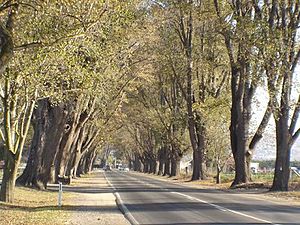
Most people in Bacchus Marsh use cars to get around. The Western Freeway is the main road connecting Bacchus Marsh to Melbourne (about 48 minutes away) and Ballarat (about 46 minutes away). This freeway separates Bacchus Marsh from its northern suburb, Darley.
The Bacchus Marsh train station is on the Ballarat line. You can catch a V/Line train to Melbourne (about 38 minutes) or Ballarat (about 34 minutes). There's also a bus service that connects the train station to the town center and other neighborhoods.
For those interested in flying, the Bacchus Marsh Airfield is located nearby in Parwan. It's used for general aviation, and there's a flying school and three gliding clubs there.
Fun and Green Spaces
One of the best places to relax in Bacchus Marsh is Maddingley Park. It's a popular spot for picnics. Near the park's south gates, you can find the Nieuwesteeg Heritage Rose Garden, which has many beautiful roses.
You can also take walks along the Lerderderg River. These walks lead to the amazing Lerderderg Gorge and the large Wombat State Park. This park is great for bushwalking and exploring old mining sites.
The Bacchus Marsh Airfield is the biggest place in Australia for recreational gliding. It's where people fly gliders for fun.
Learning in Bacchus Marsh
Bacchus Marsh has several schools for different age groups:
- Bacchus Marsh Primary School
- Darley Primary School
- Pentland Primary School
- St Bernard's Primary School (Catholic)
- Balliang East Primary
- Bacchus Marsh College
- Bacchus Marsh Grammar
For older students and adults, there are also places like Bacchus Marsh Community College and Western Institute of Technology.
Sports and Community Life
Sports like Australian rules football, Cricket, Soccer, and Netball are very popular in Bacchus Marsh.
- Local football teams like Darley Football Club and Bacchus Marsh Football Club play in the Ballarat Football League.
- The Bacchus Marsh Tigers Baseball Club plays in the Geelong Baseball Association.
- The Bacchus Marsh Scorpions Soccer Club plays at Masons Lane Reserve. Soccer has become one of the biggest sports in the area.
- Korfball is another sport that has become popular.
- Golfers can play at the Bacchus Marsh Golf Club or the Bacchus Marsh West Golf Club.
- The Bacchus Marsh Tennis Club has many courts for players of all skill levels.
- The airfield is home to three gliding clubs: Geelong Gliding Club, Melbourne Gliding Club, and Beaufort Gliding Club. Pilots from these clubs have even represented Australia in international gliding competitions!
Famous People from Bacchus Marsh
Many notable people have connections to Bacchus Marsh, including:
- Emily Bates (born 1995), an Australian rules footballer.
- Peter Carey, a famous author who has won the Booker Prize twice.
- Liam Duggan (born 1996), an AFL player.
- Frank Hardy (1917–1994), an author, and his sister Mary Hardy (1931–1985), an actor and comedian.
- Doug Hawkins (born 1960), a well-known AFL star.
- Edmond Hogan (1883–1964), who was the Premier of Victoria (a political leader) from 1927 to 1928 and again from 1929 to 1932.
- Rupert Vance Moon, who received the Victoria Cross, a very brave award.
- Helen Richey, a judge on the TV show Dancing with the Stars.
- Nick Suban (born 1990), an AFL Footballer.
- Harry "Soapy" Vallence (1905–1991), a famous Carlton Australian rules footballer.


